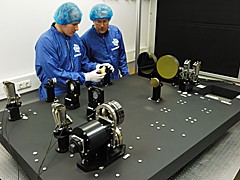Sep 19 2008
The PRIMA facility with TNO's Star Separators was successfully tested during a "first light" test at the beginning of September. PRIMA will set a new benchmark in astrometry and will enable exoplanet detection with high precision astrometric measurements as well as imaging of faint objects. The European Southern Observatory (ESO) has built the PRIMA (Phase-Referenced Imaging and Microarcsecond Astrometry) facility on the Very Large Telescope Interferometer (VLTI) in Chile. TNO's Star Separators have been installed on two VLTI Auxiliary Telescopes.
 Integration of the PRIMA UT Star Separator at TNO
Integration of the PRIMA UT Star Separator at TNO
Star Separator
TNO will provide ESO with Star Separators for all four Unit Telescopes (UT) and two Auxiliary Telescopes (AT). The Star Separator is an opto-mechanical system, designed to separate the light of two astronomical objects. The STS system is a unique combination of precision optics, advanced mechanical design and sophisticated control engineering.
Finding new planets
Since the first confirmed discovery of an exoplanet in 1995, more than 300 planets orbiting other stars have been found. Most of these discoveries were made by the radial velocity method (measuring variations in the star’s relatively velocity). Astrometry is a complementary technique to the radial-velocity method. It has a different detection bias, more suitable to planets in large orbits, similar to our own solar system. For successful exoplanet detection an astrometric accuracy of approximately 10 ?arcsec is needed, comparable to the ability to detect a Euro coin on the Moon from Earth. This is beyond the performance of the current space and ground based astronomical telescopes, including the Hubble Space Telescope.
How PRIMA works
PRIMA is composed of four major sub-systems: Star Separators, Differential Delay Lines, Metrology and Fringe Sensor Units. TNO was responsible for the development of the Star Separators. PRIMA allows simultaneous observation of two objects. One is a bright star in the field of view of the telescope and the other one the (faint) scientific object. The bright star is used to control the interferometry (fringe position). When the fringes of the bright star are stabilised, the fringes of the fainter science object can be studied. With PRIMA the global limiting magnitude of the VLTI will gain about four magnitudes. Science observations will start after the completion of a 6 months testing and characterisation phase.